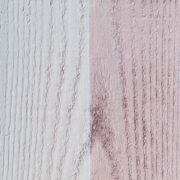Tannin Staining
Definition
Tan or brownish discoloration on the paint surface. Tannins exist in many woods, most notably cedar and redwood and can bleed through to the surface, leaving a yellowish-brown stain on the surface. These stains are more noticeable on lighter paint colors.

Causes
- Failure to adequately prime and seal the surface before painting
- Using a primer that is not tannin-stain-resistant
- Excess humidity or other moisture problems that can cause tannins to rise to the paint surface
Solutions
- Locate and correct any moisture sources.
- Remove all loose paint with a scraper or wire brush.
- Remove the stains with oxalic acid or an oxalic-based solution.
- Rinse with a pressure washer.
- Allow the surface to dry thoroughly for at least 48 hours (depending on the existing weather conditions).
- Prime the stained area with a top-quality, stain-blocking wood primer.
- If severe staining exists, apply two coats of primer. Always prime edges and ends of shingles. If possible, prime the backs of shingles prior to installation.
- Repaint using high-quality paint.
Notes
Tannin bleed is a surface problem, not a paint failure. Tannic acid will prolong the drying of oil-based primers and in some cases you will have to wait three to five days for the primer to fully cure before repainting. If staining occurs during the application of the new coat of paint, sand lightly and re-prime the area before applying the final finish.
In spite of all precautions, a certain amount of bleeding will probably occur within one year after the wood is first painted. It is best to wait one year before repainting. This allows the tannins to surface and weather away normally.
Product Recommendations
Primer
Desired Finish
Recommended Primer
Natural Wood
Exterior
Surface
Recommended Product
Satin/Low Sheen
Please note that these suggestions are provided as a service to you. We are unable to guarantee or be responsible for the results obtained by these procedures. If you have additional questions, ask any of our expert sales associates.







